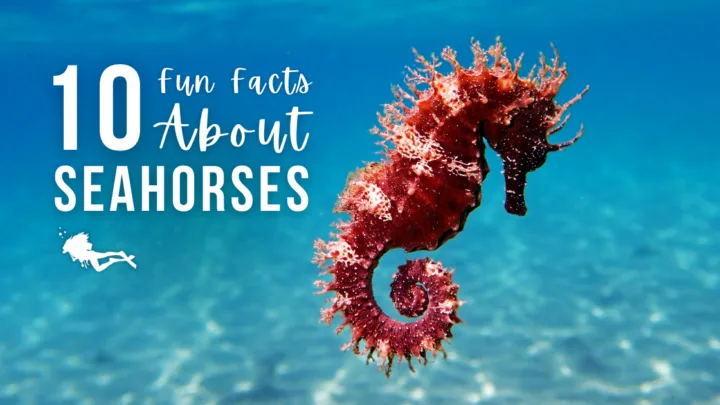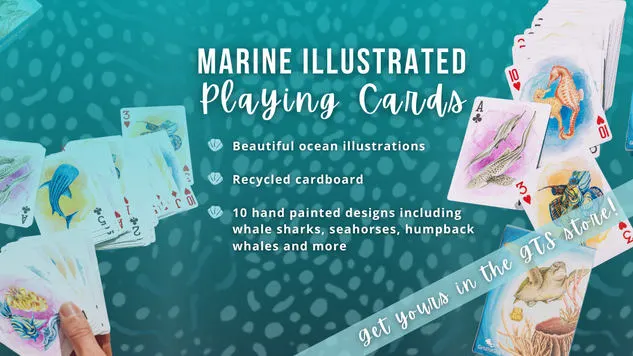Despite looking like something out of a fairy-tale, seahorses can be found in oceans all over the world. Their unique anatomy, quirky colours and delicate features make them a truly unique sight to behold in the water, yet their tiny size means that they often go unnoticed by ocean explorers.
As well as their striking appearance, sea horses are family-orientated creatures that exhibit some extremely tender character traits (more on that later), and they’ve worked their way firmly into the hearts of many scuba divers.
Here, we’ll run through some fun facts about seahorses, and we’ll give you some top tips for where to find them so you can boost your odds of spotting one of these incredible creatures on a dive!
1. Seahorses are a type of fish
Hippocampus is the Latin name for seahorse, and it translates to something along the lines of ‘horse animal’. But despite the confusing name, seahorses are a type of fish.
Like most bony fish, seahorses have a swim bladder which is a balloon-like organ that helps them to float – a bit like a BCD. They also use gills to breathe. Yet their body shape, snout, and tail, combined with the small spines coming off their bodies (more on those later), gives them an almost dragon-like appearance.
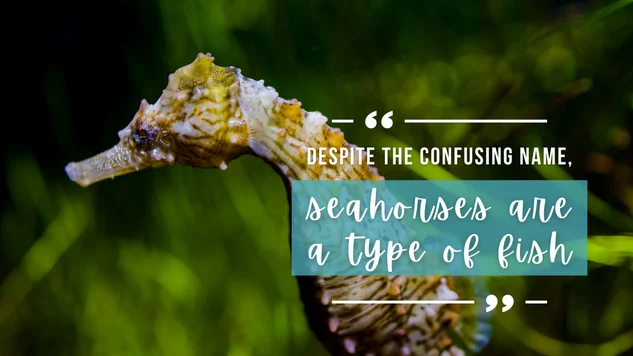
In fact, seahorses and seadragons are distant relatives – they’re both part of the Syngnathidae fish family, along with pipefish.
2. The smallest seahorse is just 14mm long
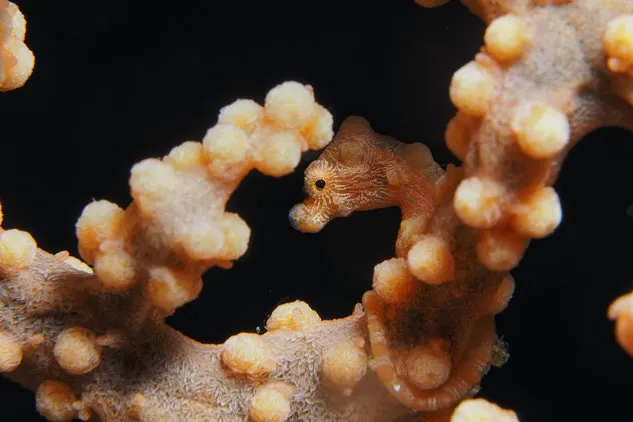
Unlike their terrestrial counterparts, seahorses are known for their tiny size. But how small are we talking? Well, that depends.
The smallest species of seahorse, Satomi’s pygmy seahorse (Hippocampus satomiae) is a miniscule 14mm in length. In contrast, the big-bellied seahorse (Hippocampus abdominalis) is one of the largest seahorses species and can grow up to 35cm in length. While this isn’t exactly huge, it makes it a LOT easier to spot on your dives!
3. Male seahorses carry the eggs during reproduction
The seahorse reproduction cycle is a fascinating process and involves an enchanting underwater performance. Courting pairs will twirl, shimmer and even entwine their tails in what is often referred to as an underwater dance recital. Once the bond is formed, the reproductive cycle begins.
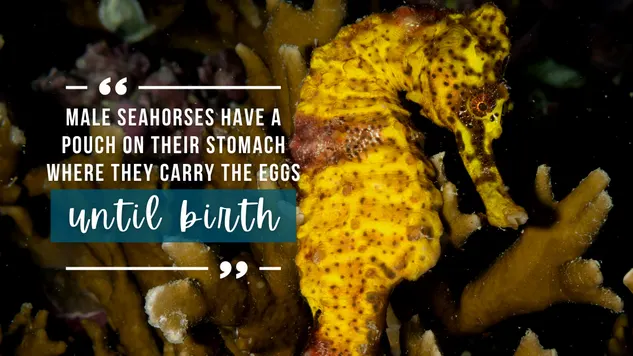
Here’s an interesting fact about seahorses for you. Once the females have produced their eggs, it’s the males that have to deal with the pregnancy. Female seahorses ‘inject’ their eggs into the males, which have a ‘pouch’ on their stomach where they carry the eggs until birth.
This can take anywhere from 10 to 42 days, depending on the species, and the happy couple will perform their dancing ritual every morning throughout this period.
4. Seahorses like long-term relationships
Maybe it’s because it’s hard to find true love when you’re the size of a pinecone and being swept around the ocean, or maybe it’s because seahorses are suckers for romance. Either way, seahorses like a long-term relationship.
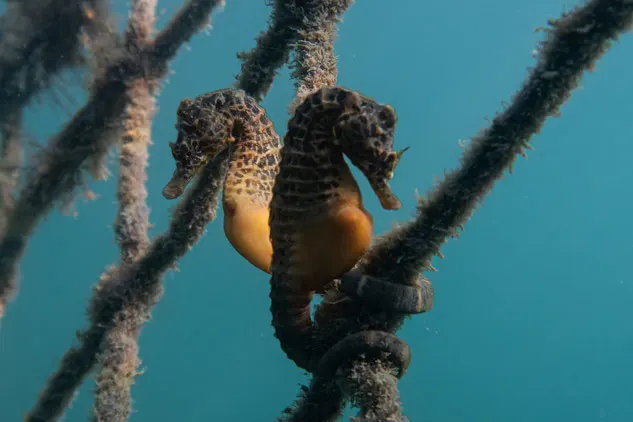
Seahorse mates will stay together for an entire breeding season, and some species will stay together for multiple seasons and several years.
In fact, some seahorses get so worried about losing their partners in a rogue current that they hold on to each other’s tails!
5. Seahorses are terrible swimmers, but they love to catch a free ride
When you think of a horse, it’s usually an image of one running wild and free across a field, mane blowing in the wind – so it would make sense for a seahorse to have some serious swimming skills, right?
But this couldn’t be further from the truth. In fact, the dwarf seahorse (Hippocampus zosterae) holds the title of being the slowest fish in the sea.
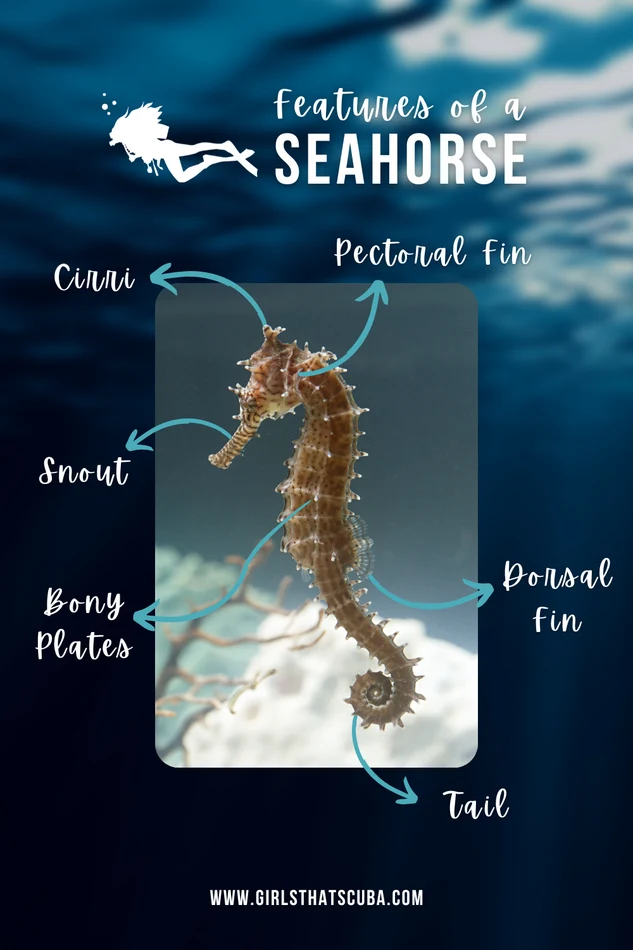
This is largely due to their bulky bodies and their unusual fin arrangement. Unlike most fish, seahorses rely on just one small dorsal fin on their back for propulsion and tiny pectoral fins at the side of their heads for steering.
But seahorses have developed a cunning way to get themselves from A to B, despite their goofy shapes, and it’s all in the tails. By wrapping their tails around bits of passing debris, or even certain animals, seahorses are able to catch free rides to all their favourite feeding, mating and hiding spots – as long as the current’s going in the right direction!
6. Seahorses don’t have stomachs, but they have big appetites
Surprisingly, seahorses can snap up prey, like copepods and tiny crustaceans, in a matter of milliseconds. But how does something so slow eat so quickly?
It’s all down to the neck – seahorses use their mighty neck tendons, combined with an upward thrusting movement, to get their snouts close to their prey in an instant. But this isn’t just a top-notch snacking strategy, it’s actually an essential seahorse survival mechanism.
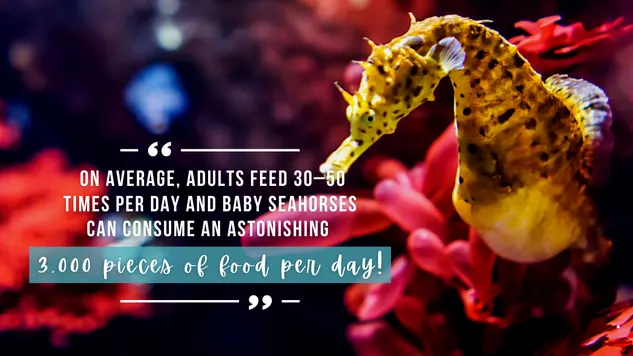
Seahorses lack teeth, so they inhale their food through their snouts. It then passes through their digestive system so quickly that seahorses have to eat almost constantly to satisfy their appetites – on average, adults feed 30–50 times per day and baby seahorses can consume an astonishing 3,000 pieces of food per day!
7. Seahorses are masters of disguise
Another reason why seahorses are so good at sneaking up on their prey is their impressive camouflage. To help them blend into the background, seahorses can change their colour to match their surroundings.
They also grow small protrusions, known as cirri, that can mimic moss, algae and other plants. And, in case that wasn’t enough, Pygmy seahorses can even grow small lumps, known as tubercules, on their bodies, making them look just like the sea fans they like to hide in!
8. There are more than 50 different species of seahorse
In fact, seahorses are so good at changing colour and shape that even scientists have a tough time identifying them. It doesn’t help that there are at least 54 different species of seahorse to choose from.
Plus, many species have been identified in recent years, so it’s always worth taking a snapshot of seahorses you encounter in case you’ve found a new one!
9. Seahorses are found on every continent… except Antarctica
All those species might make identifying your sightings a little bit tricky… but such a diverse family tree means that you can spot seahorses in tropical and temperate waters around the world. The central Indo-Pacific region is home to the greatest number of seahorse species, but you can find seahorses in the waters of an impressive 130 countries spread across 6 continents!
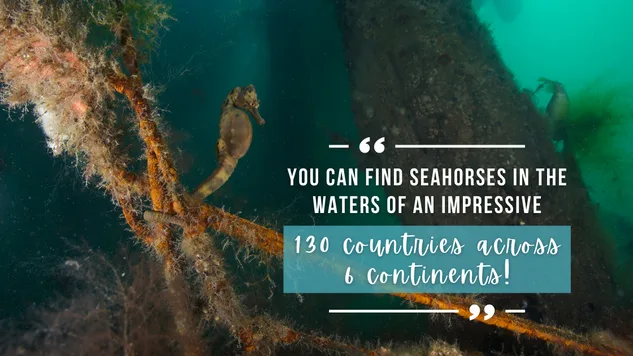
Although typically found in shallow water, hiding among mangroves, seagrass, coral reefs and other environments, you can find seahorses in open water too.
10. Seahorses need our help
Sadly, seahorses are often caught unintentionally by fisheries (termed ‘by-catch’), and some seahorses are deliberately targeted so that they can be sold as pets or used in medicine.
On top of that, many of the shallow-water environments that seahorses like to hang out in are heavily affected by human impact, including destructive fishing practices (like bottom trawlers), climate change, plastic pollution and sedimentation.
As always, there are plenty of things you can do at home and on your travels to help the plight of seahorses and our oceans (remember, it’s all connected!), including reducing your carbon footprint, eating less fish and refusing single-use plastics.
Did you learn something new about seahorses? Share this article with the buddy you most want to see a seahorse with!

About the Author
Rose has spent the last few years living in Europe, the Seychelles and Kenya, working as a dive instructor, writer and conservationist. She’s having trouble with her sinuses at the moment and can’t dive, but she hopes to be back underwater soon!

